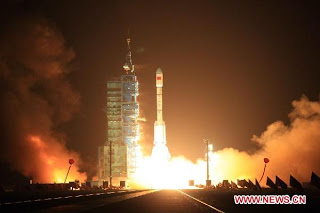The unmanned module, carried by the Long March-2FT1 rocket, will test space docking with a spacecraft later this year, paving the way for China to operate a permanent space station around 2020 and making it the world’s third country to do so.
The Tiangong-1 will orbit the Earth for about one month to await Shenzhou-8 unmanned spacecraft. Once the two vehicles successfully rendezvous, they will conduct the first space docking at a height of 340 kilometers above Earth surface.
After two docking tests, Tiangong-1 will await Shenzhou-9 and Shenzhou-10 in the next two years, according to a plan of China’s manned space program.
The 8.5-tonne Tiangong-1, with a length of 10.4 meters and maximum diameter of 3.35 meters, provides a room of 15 cubic meters for two to three astronauts to live and work.
A Long March-2FT1 carrier rocket loaded with Tiangong-1 unmanned space lab module blasts off from the launch pad at the Jiuquan Satellite Launch Center in northwest China’s Gansu Province, Sept. 29, 2011. (Xinhua/Wang Jianmin)
Unlike previous Chinese space vehicles, Tiangong-1 has a docking facility which allows it to be connected to multiple space modules in order to assemble an experimental station in low Earth orbit.
Tiangong-1 will orbit the Earth for about one month, awaiting the arrival of the Shenzhou-8 unmanned spacecraft. Once the two vehicles successfully rendezvous, they will conduct the first space docking at a height of 340 kilometers above Earth’s surface.
After two docking tests with the Shenzhou-8, Tiangong-1 will await Shenzhou-9, followed by Shenzhou-10, which will possibly carry a female astronaut, in the next two years, according to the plan for China’s manned space program.
If the astronaut in the Shenzhou-10 mission succeeds with the manual space docking, China will become the third nation after the United States and Russia to master the technology.
If the previous two steps succeed, China plans to develop and launch multiple space modules, with a goal of assembling a 60-tonne manned space station around 2020 in which Chinese astronauts will start more research projects in space.
The success of Thursday’s launch of Tiangong-1 also eased the pressure on China’s space engineers following the unsuccessful lift-off in August when a Long March-2C rocket malfunctioned and failed to send an experimental satellite into orbit.
To acquire a new and bigger rocket capable of loading a future space station’s components that will be much heavier than Tiangong-1, research and development on a carrier rocket that burns more environmentally-friendly liquid-oxygen-kerosene fuels is in progress.
If you liked this article, please give it a quick review on ycombinator or StumbleUpon. Thanks

Brian Wang is a Futurist Thought Leader and a popular Science blogger with 1 million readers per month. His blog Nextbigfuture.com is ranked #1 Science News Blog. It covers many disruptive technology and trends including Space, Robotics, Artificial Intelligence, Medicine, Anti-aging Biotechnology, and Nanotechnology.
Known for identifying cutting edge technologies, he is currently a Co-Founder of a startup and fundraiser for high potential early-stage companies. He is the Head of Research for Allocations for deep technology investments and an Angel Investor at Space Angels.
A frequent speaker at corporations, he has been a TEDx speaker, a Singularity University speaker and guest at numerous interviews for radio and podcasts. He is open to public speaking and advising engagements.


